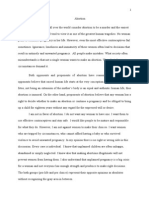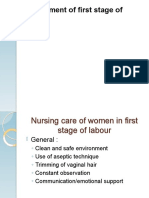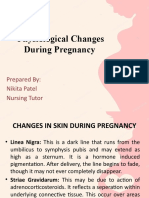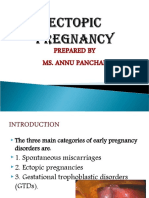Partogram or Partograph
Partogram or Partograph
Uploaded by
Charo FloresCopyright:
Available Formats
Partogram or Partograph
Partogram or Partograph
Uploaded by
Charo FloresCopyright
Available Formats
Share this document
Did you find this document useful?
Is this content inappropriate?
Copyright:
Available Formats
Partogram or Partograph
Partogram or Partograph
Uploaded by
Charo FloresCopyright:
Available Formats
PARTOGRAM or PARTOGRAPH This article can help young and novice nurses to understand about the modified partogram
prepared by WHO. INTRODUCTION: Partograph is a Greek word which means Labour Curve. Partograph or Partogram is a simple, Inexpensive tool which gives continuous pictorial overview of labour. It is the easy way to detect prolonged labour. The common obstetric Emergencies are obstructed labour and prolonged labour. Obstructed labour means no progress in descending parts inspite of good uterine contractions and the appropriate management would be the Caesarean section. In Prolonged labour the Cervix dilates slowly and incompletely and vaginal delivery may be considered under medical supervision. Obstructed and Prolonged labour complications are rupture of uterus, fetal distress and fetal Death. Slow progress in labour results in postpartum hemorrhage (PPH), Infections and Obstetric fistulae. To prevent life threatening situations in labour it is important that the signs of Obstructed & Prolonged labour identified early in Peripherals where the emergency management facilities are not available. BACKGROUND: Friedman is the first Obstetrician to provide a tool for the assessment of individual labour (Cervicograph).In 1972, Philpott developed Partogram from Cervicograph in Zimbabwe and Later Philpott and Castle introduced an Action Line & Alert Line in the Partogram. John Studd promoted the use of Partograph in United Kingdom. THE CONCEPT OF PARTOGRAPH: - It is a record of all observations made on a woman in labour - Decision making tool - Implies a functioning referral system with essential Obstetric service - It improves Efficiency and Effectiveness of Maternity Services DEFINITION: * A Partograph is a tool to help in the management of labour for the identification of women who are not likely to have a normal delivery and who need medical assistance. * Partograph is a chart in which the salient features of labour are entered in a graphic form and it provides the opportunity for early identification of deviations from normal. * A Partograph is a graphical record of progress during labour. Progress measured by cervical dilatation against time in hours & it provides a record of the important conditions of the mother & fetus that may arise during the process of labour. OVERVIEW: - The Partograph can be used by midwives and health workers with adequate training in midwifery who are able to: * Observe and conduct normal labour and delivery.
* Perform vaginal examination during labour and assess cervical dilation accurately. * Plot cervical dilation accurately on a graph against time. PURPOSE OF THE PARTOGRAPH: 1) 2) 3) 4) 5) 6) To detect abnormal progress of labour as early as possible To prevent prolonged labour To recognize CPD long before obstructed labour To assist in early decision on transfer, augmentation or termination of labour To increase the quality and regularity of all observations of mother and fetus To recognize maternal or fetal problems as early as possible
OBJECTIVE OF INTRODUCTION OF PARTOGRAPH: Partograph facilitates the providers in a) Differentiating between latent and active phase of labour and its deviation from normal b) c) Monitoring the progress of labour and well being of mother and fetus Recognizing the need for action at the appropriate time
FUNCTIONS OF PARTOGRAPH: - Give early warning in prolonged labour. - Moving to the right of the alert line serves as a WARNING for extra vigilance and specific management decisions must be made. - Other observations on the progress of labour also recorded. COMPONENTS OF THE PARTOGRAPH: Part I Assessment of fetal condition Part II Progress of labour Part III Assessment of maternal condition Part IV Outcome of labour PART I - ASSESSMENT OF FETAL CONDITION This part of graph is used to monitor and assess fetal condition A) Fetal Condition includes -Fetal Heart Rate (FHR) and Membranes and liquor. B) Moulding of the fetal skull bones. A) Fetal Condition
i)
Fetal Heart Rate * 120 160 b.p.m. Is normal and > 160 b.p.m. Tachycardia. * < 110 b.p.m. Bradycardia and < 100 b.p.m. severe Bradycardia
ii) Membranes and liquor The condition of membranes and liquor plotted in the partograph as follows Intact Membranes Ruptured Membranes + Clear liquor Ruptured Membranes + Blood-stained liquor Ruptured Membranes + Absent liquor Ruptured Membranes + Light green liquor Ruptured Membranes + Dark green liquor Ruptured Membranes + Meconium stained liquor B) Moulding the fetal skull bones: I C B A M+ M++ M+++
- It is important indication for adequacy of pelvis for fetal head. Decrease in Moulding with high head in the pelvis is a sign of Cephalo Pelvic Disproportion (CPD).It is plotted as follows: Separated bones, sutures felt easily Bones just touching each other Overlapping bones (reducible) O + ++
Severely overlapping bones (non-reducible) +++ Part II Progress of labour: This section has as its central feature a graph of cervical dilation against time. Alert Line (Health facility line) The alert line drawn from 4cm of cervical dilatation to the point of expected full dilatation at the rate of 1cm / hr. Moving to the right of alert line indicates referral of Mother to hospital. Action Line (Hospital line) Action line has drawn 4 hours to the right of alert line and parallel to it. It is critical line specific management division must be made. The progress of labour is monitored by 1. Cervical dilation
2. Descent of the head abdominal palpation of the head 3. Uterine contractions frequency/10mts and duration
1. Cervical Dilation: It gives most important information and also it is the surest way of assessing progress of labour. When progress is normal and satisfactory plotting cervical dilation remains on the Alert line or left of it. If woman admitted in active phase recording the cervical dilation starts on the alert line. 2. Descent of the Head: It is assessed by abdominal Examination by using rule of fifths to assess engagement. Rule of fifths means the palpable fifths of the fetal head are felt above the level of Symphysis pubis by abdominal examination.2/5 or less than that of the fetal head felt above the level of Symphysis pubis indicates head is engaged. By per vaginal examination findings can be confirmed that the lowest part of vertex has passed or is at the level of ischial spines. 3. Uterine contraction: In normal labour uterine contractions become more frequent and last longer as labour progresses. The observations of duration of contractions assessed by number of contraction in 10mts period, the time the contraction felt abdominally, to the time the contraction passes off. In Partogram each square represents one contraction. If contraction last for 20 seconds or less fill square with dots. If between 20-40 seconds by diagonal line and >40 seconds fill the square completely by shading. Part III Assessment of Maternal Condition Assess maternal condition regularly by monitoring. Drugs, IV fluids, Pulse - Half hourly, BP-4th hourly, Temperature - 4th hourly and Urine volume, analysis for protein and acetones every 2 to 4 hourly. Part IV Outcome of labour Based on the observations of part one, two and three and after the delivery the baby the outcome is written. Points to remember while using Partograph It is only a tool for managing labour progress Only start partograph who dont have complications and doesn't require Referral Only be started when a woman is in labour If progress of labour is satisfactory, the plotting cervical dilation remain on/to the left of the Alert line If labour is satisfactory, the dilation should move to right of the Alert line Cervical dilation plotted as X, descent of fetal head plotted as O, uterine contractions are plotted with differential shading Descent of fetal head always assessed by Rule of fifths felt above the pelvic brim, immediately before doing vaginal examination Assessing descent of the head helps in detecting progress of labour Moulding with high head indicates CPD and requires immediate referral
Infrequent vaginal examination (once in every 4hrs) When the woman arrives to the hospital the time of admission is O time A woman whose cervical dilation moves to the right of the Alert line must be transferred for obstetric interventions When Partogram should be initiated When CD is 3cm or more Uterine contractions one or more in 10mts and last for at least 20 seconds Condition need to be screened prior to Partogram Short stature, APH, Severe Pre-eclampsia, Fetal compromise, Previous caesarean section, Moderate to severe anemia, Multiple pregnancies, Mal-presentations, Very premature labour and Obvious obstructed labour Pre-requisites for its use Good understanding is essential to start Partograph -Understands normal and abnormal partograph -Necessary needed skills are accurate recording, Interpretation, and Timely communication. - Referral and intervention Quick action warranted in labour during following conditions Delay in cervical dilatation is 1cm/hr Delay in descent of the head FHR < 120 or > 160/mt on 3 observation ROM and Meconium stained liquor
- ROM and Absence of liquor and fetal skull Moulding with bones touching each other / overlapping / severe overlapping
You might also like
- Partograph PPT 1Document55 pagesPartograph PPT 1Maria Lejani Terencio100% (2)
- Obstetrical Emergencies Maternity NursingDocument100 pagesObstetrical Emergencies Maternity Nursingsanthiyasandy100% (6)
- Placental ExaminationDocument13 pagesPlacental ExaminationAnuradha Maurya75% (4)
- CPDDocument14 pagesCPDmaezu100% (1)
- Causes and Onset of LabourDocument46 pagesCauses and Onset of LabourDrpawan Jhalta50% (2)
- Bishop ScoreDocument5 pagesBishop ScoreJillian MendozaNo ratings yet
- Abortion Persuasive EssayDocument2 pagesAbortion Persuasive Essaydoriana-grayNo ratings yet
- PartographDocument33 pagesPartographKathrynne Mendoza100% (1)
- Management of First Stage of LabourDocument55 pagesManagement of First Stage of LabourBharat ThapaNo ratings yet
- Partogram CORRECTEDDocument45 pagesPartogram CORRECTEDjayasankariNo ratings yet
- Objective Structured Clinical Examination On PartographDocument58 pagesObjective Structured Clinical Examination On PartographMd AliNo ratings yet
- Management of LabourDocument16 pagesManagement of LabourAlbert MusinguziNo ratings yet
- Partograph DR OdofinDocument61 pagesPartograph DR OdofinEkiran BabajideNo ratings yet
- PRO Post Natal AssessmentDocument9 pagesPRO Post Natal AssessmentMali Kanu100% (1)
- Complication of 3rd Stage of LabourDocument48 pagesComplication of 3rd Stage of LabourPayal SharmaNo ratings yet
- Obstructed LabourDocument11 pagesObstructed Labourabhay jain100% (2)
- Physiological Changes During PregnancyDocument44 pagesPhysiological Changes During PregnancyvrutipatelNo ratings yet
- Abnormal Uterine ActionDocument64 pagesAbnormal Uterine ActionKanimozhi Kasinathan100% (1)
- Cord Prolapse: Prepared by Mrs Bini P Samuel Assistant Professor SSRCN, VapiDocument17 pagesCord Prolapse: Prepared by Mrs Bini P Samuel Assistant Professor SSRCN, Vapibinipsamuel25No ratings yet
- Managament of The 2nd Stage of LabourDocument53 pagesManagament of The 2nd Stage of LabourJSeashark100% (2)
- Breast Complications: Presented by Sridevi Devaraj Asst - Lecturer Kcon BangaloreDocument15 pagesBreast Complications: Presented by Sridevi Devaraj Asst - Lecturer Kcon BangaloreSridevi DevarajNo ratings yet
- Face PresentationDocument52 pagesFace PresentationAnnapurna DangetiNo ratings yet
- Prolonged LabourDocument3 pagesProlonged Labourannu panchalNo ratings yet
- 3rd Stage of LabourDocument10 pages3rd Stage of LabourBhawna JoshiNo ratings yet
- Prolonged LaborDocument32 pagesProlonged Labormaezu50% (2)
- Mechanism of LabourDocument15 pagesMechanism of Labourangel panchal100% (1)
- Mechanism of LabourDocument18 pagesMechanism of Labournamitha100% (1)
- OccipitoposteriorDocument11 pagesOccipitoposteriorVijith.V.kumar100% (1)
- Obg - AntentalDocument57 pagesObg - AntentalA suhasini0% (1)
- Obs Vaginal ExaminationDocument15 pagesObs Vaginal Examinationaparna shamaNo ratings yet
- Adolecent Pregnancy, Elderly Primigravida, Grand Multipara IntroductionDocument3 pagesAdolecent Pregnancy, Elderly Primigravida, Grand Multipara IntroductionmercyNo ratings yet
- Instruments For Examination in Obstetrics and Gynecology: Section 1Document12 pagesInstruments For Examination in Obstetrics and Gynecology: Section 1JennyDaniel100% (2)
- Manual Removal of PlacentaDocument2 pagesManual Removal of PlacentaKrishnaveni Murugesh100% (1)
- Occipito Posterior PositionDocument52 pagesOccipito Posterior PositionVijith.V.kumar100% (3)
- Prolong LabourDocument5 pagesProlong LabourNishaThakuri100% (1)
- 27 Purpureal Venous Thrombosis and Pulmonary Embolism by Shambuling HebballiDocument14 pages27 Purpureal Venous Thrombosis and Pulmonary Embolism by Shambuling HebballiSamhitha Ayurvedic Chennai100% (1)
- Primary Uterine InertiaDocument4 pagesPrimary Uterine InertiaTrisha Cayabyab100% (1)
- Diagnosis of PregnancyDocument25 pagesDiagnosis of PregnancyA suhasiniNo ratings yet
- Cesearean Section FinalDocument62 pagesCesearean Section FinalsanthiyasandyNo ratings yet
- New NORMAL PUERPERIUMDocument21 pagesNew NORMAL PUERPERIUMvarshaNo ratings yet
- Mannual Removal of Placenta: Presented By-Bhawna Joshi MSC. (N) 2 YearDocument23 pagesMannual Removal of Placenta: Presented By-Bhawna Joshi MSC. (N) 2 YearBhawna JoshiNo ratings yet
- Amniotic Fluid EmbolismDocument5 pagesAmniotic Fluid EmbolismPatel AmeeNo ratings yet
- IUGRDocument11 pagesIUGRAnastasiafynn100% (1)
- Antenatal CareDocument19 pagesAntenatal CareIshika RoyNo ratings yet
- Episiotomy TeachingDocument16 pagesEpisiotomy TeachingkamalbakshirNo ratings yet
- Normal LabourDocument185 pagesNormal LabourAnnapurna Dangeti100% (1)
- System Wise Physiological ChangesDocument24 pagesSystem Wise Physiological ChangesKinjal VasavaNo ratings yet
- Fetal Skull and Maternal PelvisDocument28 pagesFetal Skull and Maternal PelvisAshwanee Jharia0% (1)
- OB-High Risk PregnancyDocument18 pagesOB-High Risk PregnancyBree EtienneNo ratings yet
- Ectopic PregnancyDocument34 pagesEctopic Pregnancyannu panchalNo ratings yet
- Assessment of Maternal MeasuresDocument13 pagesAssessment of Maternal Measuresvikas tak100% (2)
- Examination of PlacentaDocument2 pagesExamination of PlacentaAnju Margaret100% (1)
- Eclampsia ManagementDocument28 pagesEclampsia ManagementVarna MohanNo ratings yet
- Abortion: DEFINITION-Abortion Is The Separation Partial orDocument77 pagesAbortion: DEFINITION-Abortion Is The Separation Partial orPadmaNo ratings yet
- Ectopic PregnancyDocument10 pagesEctopic PregnancyXo Yem0% (1)
- Antenatal PreparationDocument26 pagesAntenatal Preparationvaishali TMU studentNo ratings yet
- Female PelvisDocument4 pagesFemale PelvisAnnapurna Dangeti100% (3)
- Role of Dietary Fibers and Nutraceuticals in Preventing DiseasesFrom EverandRole of Dietary Fibers and Nutraceuticals in Preventing DiseasesRating: 5 out of 5 stars5/5 (1)
- PartographDocument6 pagesPartographalyssa marie salcedo100% (2)
- Definition:-The Partograph Is A Simple Chart orDocument12 pagesDefinition:-The Partograph Is A Simple Chart orBharat Thapa0% (1)
- Partograph 3Document49 pagesPartograph 3Geeta BhardwajNo ratings yet
- Veterinary Gynaecology ObstetricsDocument8 pagesVeterinary Gynaecology ObstetricsSuryakantaRoulTuntunNo ratings yet
- Chap 1 - Introduction - The Environment at RiskDocument9 pagesChap 1 - Introduction - The Environment at RiskAshwin ShajithNo ratings yet
- On Exam After BirthDocument4 pagesOn Exam After Birthstephen X-SILVERNo ratings yet
- Maternal and Child Health Nursing TestDocument21 pagesMaternal and Child Health Nursing TestAt Day's Ward50% (2)
- Polytechnic University of The Philippines Sto Tomas Branch Sto. Tomas, BatangasDocument4 pagesPolytechnic University of The Philippines Sto Tomas Branch Sto. Tomas, BatangasJonalyn PlazaNo ratings yet
- Method of Mating 14.10.10 New Microsoft Office PowerPoint PresentationDocument15 pagesMethod of Mating 14.10.10 New Microsoft Office PowerPoint PresentationDhanasingh Naik B SNo ratings yet
- Kendriya Vidyalaya Sec-4 R.K. Puram: Total Assignment 5Document5 pagesKendriya Vidyalaya Sec-4 R.K. Puram: Total Assignment 5Richa SinghNo ratings yet
- Animations CompleteDocument8 pagesAnimations CompleteJeff SmithNo ratings yet
- Multiple Pregnancy: Fahad ZakwanDocument60 pagesMultiple Pregnancy: Fahad Zakwanhaisuresh100% (1)
- Family Planning MethodsDocument28 pagesFamily Planning MethodsArtemio TupanNo ratings yet
- Chapter 36-1 Reproductive SystemsDocument25 pagesChapter 36-1 Reproductive Systemsnancie8No ratings yet
- Case Study in Obstetrics and Gynaecology - Lecture Notes, Study Material and Important Questions, AnswersDocument11 pagesCase Study in Obstetrics and Gynaecology - Lecture Notes, Study Material and Important Questions, AnswersM.V. TV100% (2)
- 10.1 SummaryDocument29 pages10.1 Summarylestari pamungkas100% (1)
- The Effect of Formal Education On Nigerian Women's Attitude Towards Family PlanningDocument68 pagesThe Effect of Formal Education On Nigerian Women's Attitude Towards Family PlanningSabanettNo ratings yet
- Monday Tuesday Wednesday Thursday Friday: GRADES 1 To 12 Daily Lesson LogDocument9 pagesMonday Tuesday Wednesday Thursday Friday: GRADES 1 To 12 Daily Lesson LogJerwin Monsales100% (1)
- Twin Pregnancy: Associate Professor Blidaru Iolanda-Elena, MD, PHDDocument44 pagesTwin Pregnancy: Associate Professor Blidaru Iolanda-Elena, MD, PHDEgieAprian100% (1)
- 7.recent Advances in Contraceptive TechnologyDocument25 pages7.recent Advances in Contraceptive TechnologyVeena Dalmeida100% (1)
- Herbert S. Klein - A Population History of The United States (2004)Document316 pagesHerbert S. Klein - A Population History of The United States (2004)aaaa100% (1)
- Incidence of Placenta Previa, Management Andmaternal Outcome in Region of Taif. KSADocument6 pagesIncidence of Placenta Previa, Management Andmaternal Outcome in Region of Taif. KSAYakobus Anthonius SobuberNo ratings yet
- What Is in Vitro Fertilization (IVF) and Its ProcessDocument4 pagesWhat Is in Vitro Fertilization (IVF) and Its ProcessPlanet womenNo ratings yet
- Astrology & Fertility 101Document3 pagesAstrology & Fertility 101Deepak MishraNo ratings yet
- Family PlanningDocument2 pagesFamily PlanningJoe Randy100% (1)
- Birth Control Comparison Chart 2018Document1 pageBirth Control Comparison Chart 2018Eric SandesNo ratings yet
- High Risk PregnancyDocument35 pagesHigh Risk PregnancykenNo ratings yet
- OB Answer KeyDocument23 pagesOB Answer Keyicy431No ratings yet
- Abortion and MTP Act and Medicolegal ImportanceDocument64 pagesAbortion and MTP Act and Medicolegal ImportanceRoman MamunNo ratings yet
- Philippines Undergone Demographic TransitionDocument3 pagesPhilippines Undergone Demographic TransitionNEBRIAGA, MARY S. 3-2No ratings yet
- Beginning of LifeDocument25 pagesBeginning of LifeLEENo ratings yet
- Study Questions 4Document15 pagesStudy Questions 4CGNo ratings yet

























































































